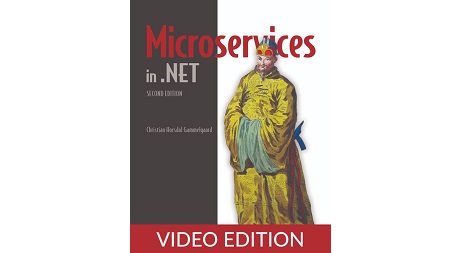English | MP4 | AVC 1280×720 | AAC 44KHz 2ch | 64 Lessons (8h 39m) | 2.97 GB
Microservices in .NET, 2nd Edition, Video Edition
A clear presentation of the latest best practices. A highly recommended read.
David Paccoud, Bioclinica
- In Microservices in .NET, Second Edition you will learn how to:
- Build scalable microservices that are reliable in production
- Optimize microservices for continuous delivery
- Design event-based collaboration between microservices
- Deploy microservices to Kubernetes
- Set up Kubernetes in Azure
Microservices in .NET, Second Edition is a comprehensive guide to building microservice applications using the .NET stack. After a crystal-clear introduction to the microservices architectural style, it teaches you practical microservices development skills using ASP.NET. This second edition of the bestselling original has been revised with up-to-date tools for the .NET ecosystem, and more new coverage of scoping microservices and deploying to Kubernetes.
Microservice architectures connect independent components that must work together as a system. Integrating new technologies like Docker and Kubernetes with Microsoft’s familiar ASP.NET framework and Azure cloud platform enables .NET developers to create and manage microservices efficiently.
Microservices in .NET, Second Edition teaches you to build and deploy microservices using ASP.NET and Azure services. It lays out microservice architecture simply, and then guides you through several real-world projects, such as building an ecommerce shopping cart. In this fully revised edition, you’ll learn about scoping microservices, deploying to Kubernetes, and operations concerns like monitoring, logging, and security.
Table of Contents
1 Part 1. Getting started with microservices
2 Microservices at a glance
3 Microservice characteristics
4 Why microservices
5 Costs and downsides of microservices
6 Serving a user request – An example of how microservices work in concert
7 A .NET microservices technology stack
8 Adding ASP.NET MVC to the project
9 A basic shopping cart microservice
10 Implementing the Shopping Cart microservice
11 The Shopping Cart microservice’s API for other services
12 Fetching product information
13 Implementing a basic event feed
14 Deploying a microservice to Kubernetes
15 Putting the Shopping Cart microservice in a container
16 Running the shopping cart container in Kubernetes
17 Running the shopping cart container on Azure Kubernetes Service
18 Running the shopping cart in AKS
19 Part 2. Building microservices
20 Identifying and scoping microservices
21 Example – Point-of-sale system
22 The secondary driver for scoping microservices – Supporting technical capabilities
23 Identifying technical capabilities
24 What to do when the correct scope isn’t clear
25 Planning to carve out new microservices later
26 Microservice collaboration
27 Events – Asynchronous collaboration
28 Implementing collaboration
29 Implementing an event-based collaboration
30 Building a Docker container special offers microservice
31 Data ownership and data storage
32 Rule 2 – Replicate for speed and robustness
33 Where does a microservice store its data
34 Implementing data storage in a microservice
35 Storing events raised by a microservice
36 Setting cache headers in HTTP responses
37 Designing for robustness
38 Using trace IDs
39 The client side’s responsibility for robustness
40 Implementing robustness patterns
41 Implementing a circuit breaker with Polly
42 Writing tests for microservices
43 Service-level tests – Testing a microservice from outside its process
44 Testing libraries – Microsoft.AspNetCore.TestHost and xUnit
45 Writing unit tests using Microsoft.AspNetCore.TestHost
46 Writing service-level tests
47 Part 3. Handling cross-cutting concerns – Building a reusable microservice platform
48 Cross-cutting concerns – Monitoring and logging
49 Tracing requests across microservices
50 Implementing the monitoring endpoints
51 Adding a trace ID to all log messages
52 Securing microservice-to-microservice communication
53 Authorizing users in microservices
54 Limiting which microservices can communicate
55 Building a reusable microservice platform
56 Packaging and sharing cross-cutting code with NuGet
57 The ASP.NET pipeline
58 Writing middleware
59 Part 4. Building applications
60 Creating applications over microservices
61 Patterns for building applications over microservices
62 Backend for frontend (BFF) pattern
63 Example – A shopping cart and a product list
64 Creating the shopping cart GUI
Resolve the captcha to access the links!
